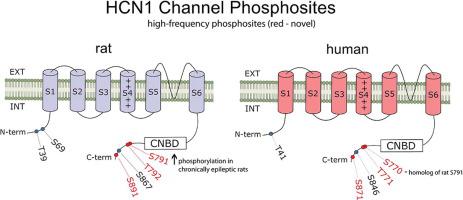Neuroscience ( IF 3.3 ) Pub Date : 2021-02-09 , DOI: 10.1016/j.neuroscience.2021.01.038 F A Concepcion 1 , M N Khan 1 , J-D Ju Wang 2 , A D Wei 2 , J G Ojemann 3 , A L Ko 4 , Y Shi 5 , J K Eng 6 , J-M Ramirez 3 , N P Poolos 1

|
Because hyperpolarization-activated cyclic nucleotide-gated (HCN) ion channels modulate the excitability of cortical and hippocampal principal neurons, these channels play a key role in the hyperexcitability that occurs during the development of epilepsy after a brain insult, or epileptogenesis. In epileptic rats generated by pilocarpine-induced status epilepticus, HCN channel activity is downregulated by two main mechanisms: a hyperpolarizing shift in gating and a decrease in amplitude of the current mediated by HCN channels, Ih. Because these mechanisms are modulated by various phosphorylation signaling pathways, we hypothesized that phosphorylation changes occur at individual HCN channel amino acid residues (phosphosites) during epileptogenesis. We collected CA1 hippocampal tissue from male Sprague Dawley rats made epileptic by pilocarpine-induced status epilepticus, and age-matched naïve controls. We also included resected human brain tissue containing epileptogenic zones (EZs) where seizures arise for comparison to our chronically epileptic rats. After enrichment for HCN1 and HCN2 isoforms by immunoprecipitation and trypsin in-gel digestion, the samples were analyzed by mass spectrometry. We identified numerous phosphosites from HCN1 and HCN2 channels, representing a novel survey of phosphorylation sites within HCN channels. We found high levels of HCN channel phosphosite homology between humans and rats. We also identified a novel HCN1 channel phosphosite S791, which underwent significantly increased phosphorylation during the chronic epilepsy stage. Heterologous expression of a phosphomimetic mutant, S791D, replicated a hyperpolarizing shift in Ih gating seen in neurons from chronically epileptic rats. These results show that HCN1 channel phosphorylation is altered in epilepsy and may be of pathogenic importance.
中文翻译:

在人类癫痫患者和颞叶癫痫动物模型中通过质谱绘制的 HCN 通道磷酸化位点
因为超极化激活的环核苷酸门控 (HCN) 离子通道调节皮质和海马主要神经元的兴奋性,这些通道在脑损伤或癫痫发生后癫痫发展过程中发生的过度兴奋性中起关键作用。在由毛果芸香碱诱导的癫痫持续状态产生的癫痫大鼠中,HCN 通道活性通过两种主要机制下调:门控中的超极化转变和 HCN 通道介导的电流幅度降低,I h. 因为这些机制受到各种磷酸化信号通路的调节,我们假设在癫痫发生过程中磷酸化变化发生在单个 HCN 通道氨基酸残基(磷酸位点)。我们收集了雄性 Sprague Dawley 大鼠的 CA1 海马组织,这些大鼠因毛果芸香碱诱导的癫痫持续状态和年龄匹配的幼稚对照而癫痫。我们还包括切除的含有致癫痫区 (EZ) 的人脑组织,其中癫痫发作与我们的慢性癫痫大鼠进行比较。通过免疫沉淀和胰蛋白酶凝胶消化富集 HCN1 和 HCN2 同种型后,通过质谱分析样品。我们从 HCN1 和 HCN2 通道中鉴定了许多磷酸化位点,代表了对 HCN 通道内磷酸化位点的新调查。我们发现人类和大鼠之间存在高水平的 HCN 通道磷位点同源性。我们还发现了一种新的 HCN1 通道磷酸化位点 S791,它在慢性癫痫阶段经历了显着增加的磷酸化。拟磷突变体 S791D 的异源表达复制了在慢性癫痫大鼠的神经元中看到了门控。这些结果表明,HCN1 通道磷酸化在癫痫中发生了改变,并且可能具有致病重要性。



























 京公网安备 11010802027423号
京公网安备 11010802027423号